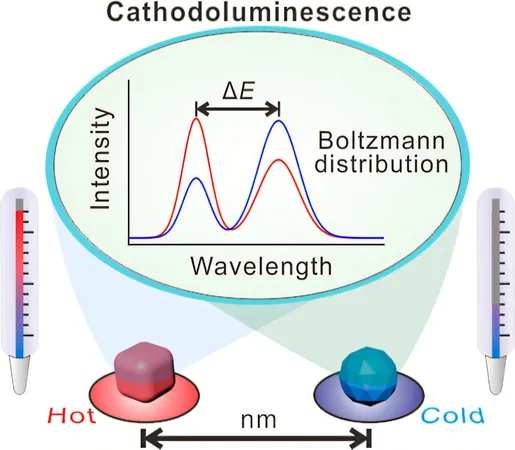
Revolutionary Nanothermometer Set to Transform Material Science: Real-Time Temperature and Structure Observation!
2025-01-13
Author: Jacob
Introduction
In a groundbreaking development in material science, researchers have unveiled a versatile nanothermometer that allows for the real-time observation of ultrafine structures and temperature variations in materials. This innovative technology is expected to enhance our understanding of the intricate correlation between material structures and their thermodynamic properties, offering exciting prospects for the development of advanced materials.
Research Leadership
Leading this research is Professor Oh-Hoon Kwon from the Department of Chemistry at UNIST, who has announced the creation of a sophisticated nanothermometer capable of precisely measuring temperatures in micro-samples through transmission electron microscopy (TEM). This technology not only aids in scrutinizing material microstructures but also allows for simultaneous temperature measurements.
How It Works
How does it work? The newly designed nanothermometer gauges temperature by analyzing the cathodoluminescence (CL) spectrum emitted by specially engineered nanoparticles when exposed to an electron beam. This clever dual-use of the electron beam as both an illumination source and a temperature probe marks a significant advancement in the field.
Overcoming Limitations
While previous iterations of nanothermometers could be employed with in situ TEM to monitor changes in microstructure, they faced limitations. Adjustments were often necessary based on the strength of the electron beam, presenting a cumbersome hurdle for researchers striving for accuracy. However, this newly developed device promises enhanced reliability and versatility.
Material Choice and Performance
The secret to its success lies in the choice of materials. The research team selected dysprosium ions (Dy3+) as the active doping material for cathode ray emission, significantly boosting performance. Lead author Won-Woo Park elaborated on this choice, stating that the distribution of quantum states in the CL spectrum of Dy3+ is solely dependent on temperature. This aspect ensures consistency, as it follows a Boltzmann distribution that only correlates with temperature fluctuations, independent of variations in electron beam strength.
The Testing Process
In a remarkable feat, the team incorporated Dy3+ ions into yttrium vanadate (YVO4)—a robust material illuminated by high-energy electron beams—to synthesize nanothermometer particles measuring just 150 nm. During testing across a temperature spectrum from -170°C to 50°C, the newly developed thermometer demonstrated an impressive measurement error of only about 4°C.
Real-Time Observations
Furthermore, a laser beam was used to incrementally raise the temperature of the sample while the research team diligently tracked the spatial distribution of temperature changes. This pivotal advancement highlights the nanothermometer’s ability to observe material behaviors in real-time, responding dynamically to external stimuli.
Implications for Future Research
As industries increasingly demand innovative materials with tailored properties, this versatile nanothermometer may open doors to new research horizons, propelling advancements in fields ranging from nanotechnology to energy storage and electronics. Stay tuned, as this breakthrough promises to revolutionize how we observe and manipulate the micro-world around us!



 Brasil (PT)
Brasil (PT)
 Canada (EN)
Canada (EN)
 Chile (ES)
Chile (ES)
 Česko (CS)
Česko (CS)
 대한민국 (KO)
대한민국 (KO)
 España (ES)
España (ES)
 France (FR)
France (FR)
 Hong Kong (EN)
Hong Kong (EN)
 Italia (IT)
Italia (IT)
 日本 (JA)
日本 (JA)
 Magyarország (HU)
Magyarország (HU)
 Norge (NO)
Norge (NO)
 Polska (PL)
Polska (PL)
 Schweiz (DE)
Schweiz (DE)
 Singapore (EN)
Singapore (EN)
 Sverige (SV)
Sverige (SV)
 Suomi (FI)
Suomi (FI)
 Türkiye (TR)
Türkiye (TR)
 الإمارات العربية المتحدة (AR)
الإمارات العربية المتحدة (AR)